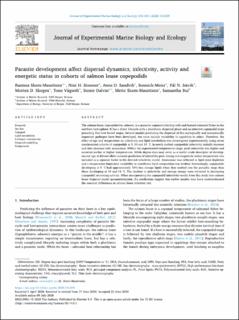| dc.contributor.author | Skern-Mauritzen, Rasmus | |
| dc.contributor.author | Sissener, Nini | |
| dc.contributor.author | Sandvik, Anne Dagrun | |
| dc.contributor.author | Meier, Sonnich | |
| dc.contributor.author | Sævik, Pål Næverlid | |
| dc.contributor.author | Skogen, Morten D. | |
| dc.contributor.author | Vågseth, Tone | |
| dc.contributor.author | Dalvin, Sussie | |
| dc.contributor.author | Skern-Mauritzen, Mette | |
| dc.contributor.author | Bui, Samantha | |
| dc.date.accessioned | 2020-10-14T12:39:41Z | |
| dc.date.available | 2020-10-14T12:39:41Z | |
| dc.date.created | 2020-07-27T15:15:30Z | |
| dc.date.issued | 2020 | |
| dc.identifier.citation | Journal of Experimental Marine Biology and Ecology. 2020, 530-531 . | en_US |
| dc.identifier.issn | 0022-0981 | |
| dc.identifier.uri | https://hdl.handle.net/11250/2682842 | |
| dc.description.abstract | The salmon louse, Lepeophtheirus salmonis, is a parasitic copepod infecting wild and farmed salmonid fishes in the northern hemisphere. It has a direct lifecycle with a planktonic dispersal phase and an infective copepodid stage preceding five host bound stages. Several models predicting the dispersal of this ecologically and economically important pathogen have been developed, but none include variability in capability to infect. Therefore, the effect of age and temperature on infectivity and lipid metabolism was investigated experimentally using seven synchronized cohorts of copepodids at 5, 10 and 15 °C. In newly molted copepodids infectivity initially increase and then decrease with senescence. Within the experimental temperature range, peak infectivity was higher and occurred earlier at higher temperatures. While degree-days may serve as a useful crude descriptor of developmental age, it did not allow accurate prediction of infectivity peak timing and magnitude unless temperature was included as a separate factor in the derived infectivity model. Senescence was reflected in lipid store depletion and a temperature dependent variability in membrane lipid composition was evident. Interestingly, copepodids developing at 5 °C had approximately 50% less storage lipids when they molted into the parasitic stage than those developing at 10 and 15 °C. The declines in infectivity and storage energy were mirrored in decreasing copepodid swimming activity. When incorporating the copepodid infectivity results from this study into salmon louse dispersal model parameterization, the predictions suggest that earlier models may have underestimated the seasonal differences in salmon louse infection risk. | en_US |
| dc.language.iso | eng | en_US |
| dc.title | Parasite development affect dispersal dynamics; infectivity, activity and energetic status in cohorts of salmon louse copepodids | en_US |
| dc.type | Peer reviewed | en_US |
| dc.type | Journal article | en_US |
| dc.description.version | publishedVersion | en_US |
| dc.source.pagenumber | 11 | en_US |
| dc.source.volume | 530-531 | en_US |
| dc.source.journal | Journal of Experimental Marine Biology and Ecology | en_US |
| dc.identifier.doi | 10.1016/j.jembe.2020.151429 | |
| dc.identifier.cristin | 1820653 | |
| dc.relation.project | Havforskningsinstituttet: 14650 | en_US |
| dc.relation.project | Norges forskningsråd: 294730 | en_US |
| cristin.ispublished | true | |
| cristin.fulltext | original | |
| cristin.qualitycode | 1 | |
